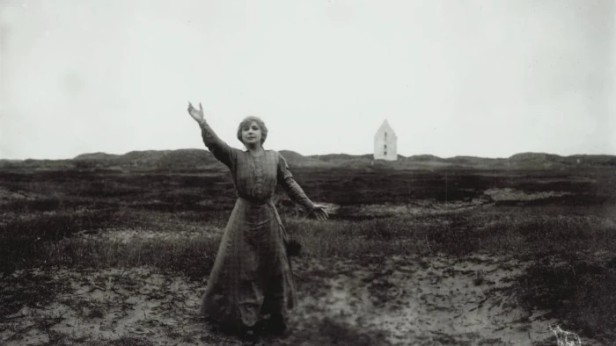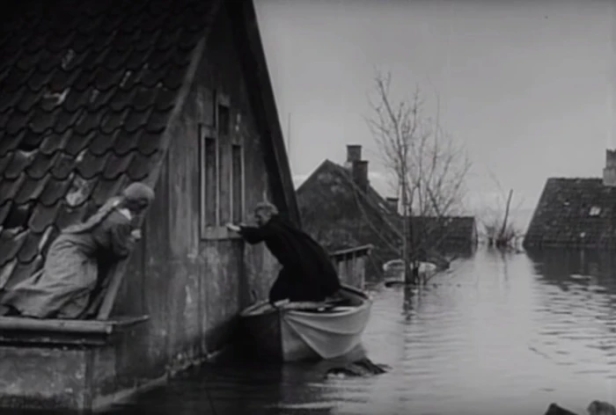Original title: Verdens Undergang
For a few years, during the 1910s, Denmark was one of European cinema’s powerhouses, particularly after director and producer August Blom took over the running of the production company Nordisk Film. The country was among the first to start making feature length films and their product was widely exported around the world, the equal of anything emanating from France, Germany or the States. In 1913, Nordisk scored a hit with Atlantis, an early disaster film based on the previous year’s Titanic tragedy. And Blum was ploughing other new furrows the following year arguably the world’s first feature-length end-of-the-world drama Verdens Undergang, known in English speaking territories as, appropriately enough, The End of the World.
The story opens deceptively, as a romantic melodrama set somewhere in Denmark and centring around two sisters, Dina (Ebba Thomsen) and Edith West (Johanne Fritz-Petersen), who live with their mine-worker father in a small coastal town. Dina abandons her working-class lover Flint (Thorleif Lund) and runs off with the handsome and wealthy mine-owner Frank Stoll (Olaf Fønss). Edith meanwhile is reunited with old friend, sailor Reymers (Alf Blütecher), the two quickly falling in love. However, their romantic idyll is short-lived when, a few years later, Stoll’s cousin, astronomer Dr Wissmann (K. Zimmerman), announces the discovery of a comet which is on a collision course with Earth. Dina is now living in bored luxury with Stoll who is more interested in making a fortune on the stock market than his wife. He sees a chance to increase his wealth when news of the comet causes the stock market to crash and he makes a killing. But nothing can stop the comet and soon the Earth is being devastated by fire and meteors falling from the sky, razing cities to the ground and causing fires and floods. Edith is caught on a rooftop when the village floods and is saved by a travelling preacher (Frederik Jacobsen) and takes her to a nearby cave for shelter, where she prays that Reymers, who was at sea when the comet arrived, is safe.

Having declared the country neutral during the First World War, the Danish authorities became increasingly nervous about betraying that status, ordering filmmakers and other artists to refrain from discussing or portraying certain sensitive subjects that they felt might lead to the country being seen to be aligning itself with one or other of the warring sides. Not for the last time, filmmakers in particular quickly realised that using fantastic subjects which seemed on the surface to be harmless flights of outlandish fantasy could allow them to slip through important messages and potentially radical ideas that the authorities would otherwise find troublesome or even offensive. So it was that Blom and his writer Otto Rung were able to get through the censors an epic tale of mass destruction and staggering loss of life at a time when much of central Europe was being devastated by war.
The film also has other political points to make. Even as early as 1916 it was becoming clear that the working classes of Europe were being used as cannon fodder for an increasingly bloody and barbaric war and Blum and Rung were quick to foreground class struggle as one of their core themes. As the comet approaches Earth, the poor finally rise up against the rich, as venal as they ever were, Stoll greedily playing the stock market and manipulating the media as catastrophe looms for his own benefit. The rich have their shelters (fat lot of good it does them) and are happy enough to leave the dispossessed to their fates, though in the end it’s the poor and the meek who do indeed inherit what’s left of the Earth. A year after End of the World was released, the Russian people would rise up and overthrow the Tsar making Blom’s film look all the more like an accidental work of prophecy.

There’s a religious strand to the film too. A preacher drifts in and out of the plot adding little but a few Biblical homilies, but that undeniable “the meek shall inherit the Earth” quality about some of the film is not-so-subtly delivered and the very striking climax takes place in and around a crumbling church, one of the few man-made structures to survive the disaster.
There’s a lot of money evident on the screen, from the ambitious special effects (of course they look primitive compared to today’s slick but often soulless CG imagery, but in 1916 there was nothing even remotely like this) to the haunting post-apocalyptic landscapes (how on Earth did they realise that flooded village, short of actually sinking a real place?). The destruction of the Earth is very well presented for a film of its age and Blom and his cinematographer, Louis Larsen (later the director of , use atmospheric lighting and inventive angles to extraordinary effect.

If truth be told, the romantic entanglements of the first reel are hard going, with the characters drawn in the broadest of strokes, their relationships sometimes bordering on the farcical. But once the comet is spotted – we first see it as a distant object in the sky, growing ever larger as it closes in on the planet – things perk up immeasurably and from there on, the pace rarely slackens. Audiences lapped it all up and the film was a huge success, perhaps acting as a safety valve for mounting fears about the spread and extent of the war, though lingering interest in the 1910 approach of Halley’s Comet, very much still fresh in the minds of those who witnessed it, helped no end too.
But the film really succeeds because of its extraordinary visuals (and not just those in the effects sequences), the sheer scale of the story and yes, even those soppy love stories that look unconvincing today but which have engaged viewers of 1916 in a story that might have seemed a bit too outlandish for them without the romance. The political and religious subtexts were doubtless draws too. Whatever brought the audiences in, the film was a box office smash at the time and it remains a powerful, hugely ambitious and pioneering piece of screen science fiction.
It’s always interesting to look back on films like this in comparison or contrast to how such genres have become specifically popular in this era. Certainly with the most personally familiar last shot of a man and woman embracing each other in love to give some sense of hope. Thank you, Kevin, for your review.
LikeLiked by 2 people